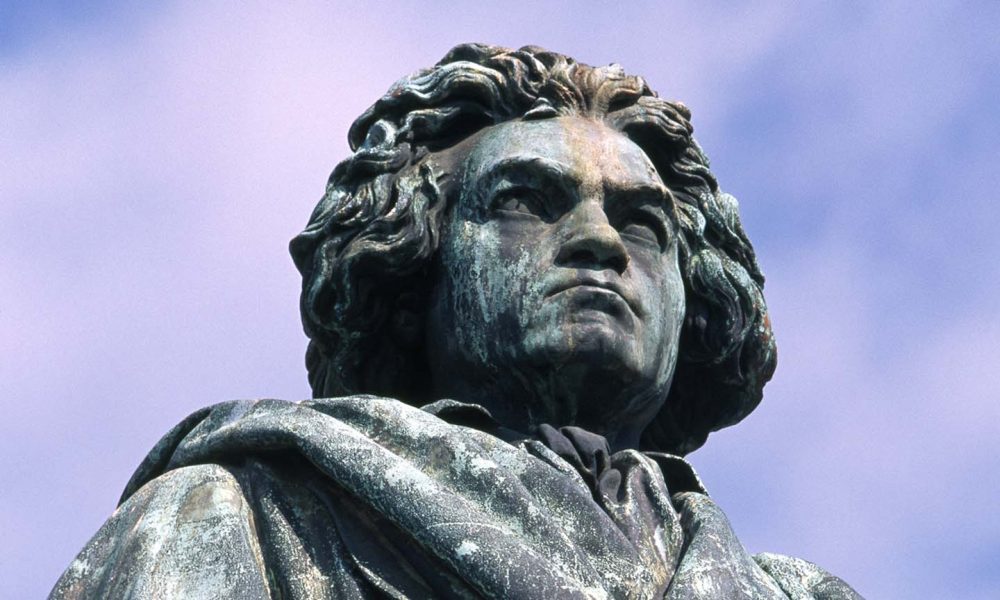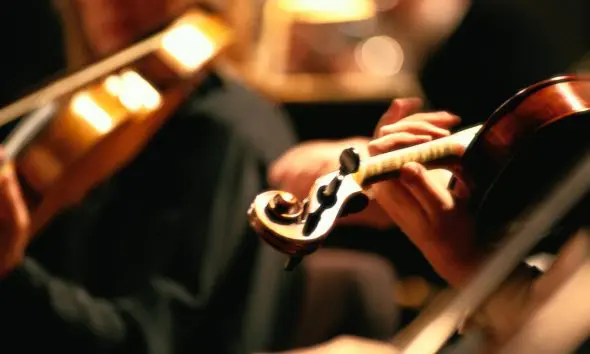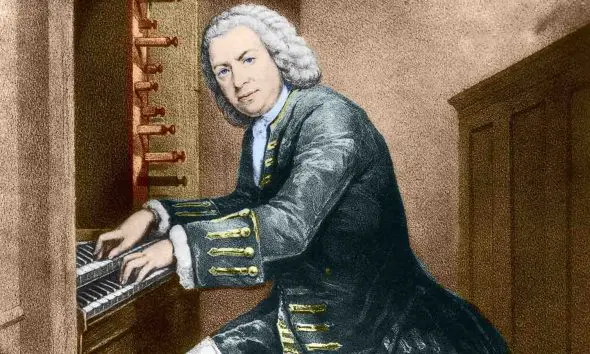Best Beethoven Works: 10 Essential Pieces By The Great Composer
Discover our selection of the best Beethoven works including symphony, concerto, and piano sonata masterpieces.

Ludwig van Beethoven is one of the most influential and significant composers of all time. He was the predominant musical figure in the transitional period between the Classical and Romantic eras, and despite suffering far-reaching medical and emotional torments (he became completely deaf by the age of 40) his music is a testament to the human spirit in the face of cruel misfortune. Discover our selection of the best Beethoven works, including symphony, concerto, opera, string quartet, and piano sonata masterpieces by the great composer.
Listen to the best of Beethoven on Apple Music and Spotify.
Symphony No.3 in E flat, op.55 – ‘Eroica’ Symphony
Beethoven’s ‘Eroica’ Symphony completed in 1804, changed the musical world and is perhaps his defining work. At a stroke, orchestral music moves into another dimension, with a breadth of conception and emotional freight and range beyond anything previously dreamed of, the exact concision and classical symmetry of Mozart is left behind. It was originally dedicated to Napoleon – a dedication Beethoven removed in a rage on hearing he had made himself Emperor. What Beethoven did here was to understand the possibilities of the sonata form, and thematic development, and then revel in his freedom. The ‘Eroica’ Symphony’s influence extended far into the future, its impact immeasurable upon composers ranging from Schubert to Berlioz to Wagner and later Mahler. In this symphony, Beethoven sought a new path for himself; in the end, he found one that shaped music for a century.
Symphony No. 9 in D minor, op. 125 – ‘Choral’ Symphony
Beethoven’s Symphony No. 9 is one of Beethoven’s greatest compositions and one of the greatest symphonies ever composed. Symphony No. 9 is also known as the ‘Choral’ Symphony as its final movement features four vocal soloists and a chorus who sing a setting of Schiller’s poem An Die Freude (Ode To Joy). In the ‘Choral’ Symphony, Beethoven took the structure of a Classical symphony to its limits in expression of his lofty philosophical theme: the unity of mankind and our place in the universe. While it appears to follow a conventional four-movement symphonic model, its massive choral fourth movement was not at all conventional. Beethoven’s ‘Choral’ Symphony became a source of inspiration to composers who followed and a keystone of the 19th-century Romantic movement.
Piano Sonata No.30 in E, op.109
Beethoven wrote 32 piano sonatas, the last three being a trilogy that belong together. The first of the three, No.30 in E, is one of the loveliest things he wrote, and is rather shorter than some of its predecessors, with a crystalline surface hiding great mysteries and intricacies of form and harmony. The short first two movements, the former emerges out of what sounds like gently tinkling raindrops, are just a prelude to the last – a chorale-like theme (and variations) that covers all of the ground between Bach and Chopin before spinning itself into a delirium of ecstasy that subsides back into the theme with a blessed sense of homecoming. It is 20 minutes of the most sustained musical rapture you could imagine and one of the best Beethoven works.
String Quartet No.14 in C sharp minor, op.131
The quartet is the most personal of compositions – it is music reduced to its absolute fundamentals with four players in quasi-spontaneous interaction. Beethoven’s last quartets are an extreme form, far from easy listening and incredibly intense, a kind of conversation with God, and this was the composer’s own favorite. It took Beethoven a lifetime to be able to write this, so don’t expect to get it on first hearing – keep at it, however, and its logic and truthfulness will soon dawn. There are seven movements, played without a break, with moments of almost complete musical stasis and other instances that sound as though Bach has been reincarnated. After hearing this string quartet five days before his death, Schubert remarked, “After this, what is left for us to write?”
Piano Concerto No.5 in E flat major – ‘Emperor’ Concerto
The ‘Emperor’ Concerto was not so-named by Beethoven, but it has majesty to spare, with an expansive surface and overwhelmingly major-key feel (disguising much harmonic and thematic intensity) that makes it a great showpiece for the soloist. Starting with three chords that expand into a flourish of mini cadenzas, it ends with a triumphant, vaulting Rondo that gallops towards a joyful end. These frame a slow movement that is one of Beethoven’s most rapt creations – a serene hymn with the piano rhapsodizing dreamily along. It’s a muscular piece, happily devoid of anguish but hardly of depth, a great and easy introduction to what Beethoven was all about, and one of the best Beethoven works.
Symphony No.7 in A, op.92
This is a sunny piece, and its premiere, at a concert for soldiers wounded at the 1813 Battle Of Hanau, was auspicious – it sounds like a celebration at the end of the nightmare of war. It is all momentum: there is no slow movement, but a half-playful, half-solemn Allegretto that brilliantly combines separate melodies and rhythms into a typically profound whole, leading to the bouncy final movements – increasingly lively and impetuous – that led Wagner to call the symphony “the apotheosis of the dance”. The way the themes melt into restful woodwind interludes is particularly gorgeous.
Fidelio, op.72
Beethoven was no natural when it came to opera – too high-minded and too idealistic for the grubby world of drama and the shades of human motivation – but Fidelio, his only effort in the genre, has astonishing, blazing periods that more than compensate for its patchy moments. There are certain operatic scenes that never fail to tingle the scalp. Tosca stabbing her lecherous blackmailer to death, or Carmen fending off her murderous ex, for example. But the moment when Fidelio reveals himself to be a woman, heroically saves her husband, and then pulls a pistol on her evil nemesis is a firecracker to beat them all. The ‘Prisoners’ Chorus’ from Act 1 is an unforgettable highlight. Fidelio/Leonore persuades the chief jailer Rocco to let the prisoners out to feel fresh air and sunlight so that she can search for her husband. Their chorus ‘O Welche Lust’ (‘O, What Joy’) is an expression of musical ecstasy, all the more potent for the atmosphere of constraint.
Symphony No. 5 in C minor, Op. 67
Beethoven’s Symphony No. 5 is one of the most frequently performed symphonies and one of the best-known compositions in classical music. The symphony begins with a distinctive four-note opening motif that recurs in various forms throughout the work, which Beethoven allegedly described to his secretary and biographer Anton Schindler as “Fate knocking at the door.” Shortly after completing Symphony No. 3 (‘Eroica’), Beethoven began to sketch ideas for his fifth symphony, which he composed between 1804 and 1808. During this productive period of his career, his sketch books also show preliminary work on Symphony No. 4, Symphony No. 6, Piano Concerto No. 4, and Fidelio. Symphony No. 5 premiered on December 22, 1808, in Vienna at a famous concert which also included the premieres of Symphony No. 6 and Piano Concerto No. 4.
Violin Concerto in D, op.61
Written double-quick in the middle of an immensely creative period, the Violin Concerto in D, Beethoven’s most consistently lyrical work, allowed him to express pure musical serenity while his more intense side was coming out in compositions like the Coriolan Overture. It is really a 40-minute outpouring of untroubled melody, with moments of harmonic and dynamic surprise in the orchestra hardly affecting the surface. Though it was a failure at its premiere (it was not performed again until Joseph Joachim rediscovered it in 1844), now it is one of Beethoven’s most popular pieces.
Violin Sonata No.9, op.47 – ‘Kreutzer’ Sonata
We should remember that Beethoven’s composing life didn’t begin with Eroica – in fact, had he died in 1803, we would still consider him a great. This sonata was written a few months before the third symphony and, like many of the works around this period, shows a great, restless striving. The first movement battles between an anguished minor-key theme and a typically hymn-like interlude; the second is a sunny, placid theme and variations; while the last is a jovial tarantella. The work lasts about twice as long as any previous sonata, allowing a great depth of musical and emotional development – and it’s very hard to play.
Recommended Recording
The New Complete Beethoven Essential Edition includes all of Beethoven’s music on 95 CDs by over 200 of the greatest Beethoven performers, including Claudio Arrau, Amadeus Quartet, Claudio Abbado, Martha Argerich, Karl Böhm, Alfred Brendel, Riccardo Chailly, Emerson String Quartet, Dietrich Fischer-Dieskau, Pierre Fournier, Emil Gilels, John Eliot Gardiner, Maria João Pires, Wilhelm Kempff, Herbert von Karajan, Yehudi Menuhin, Anne-Sophie Mutter, Murray Perahia, Maurizio Pollini, and Mitsuko Uchida.
The New Complete Beethoven Essential Edition can be bought here.
Discover more of our articles collecting the best works of composers through the ages.





classified
January 9, 2024 at 4:08 pm
Dope article, who was the author? I’m doing a school project on him and I kinda need the author.
David B. Alexander
March 11, 2024 at 10:05 am
It is hard to write articles with the topic “The best of…” but this is a very thoughtful set of choices from the variety of Beethoven’s creativity, and the comments accompanying each clearly show the writer’s understanding and enjoyment of each of the pieces of music. I think the choices made here effectively cover the major genres in which he wrote, without lowering the standard simply to include a given genre.